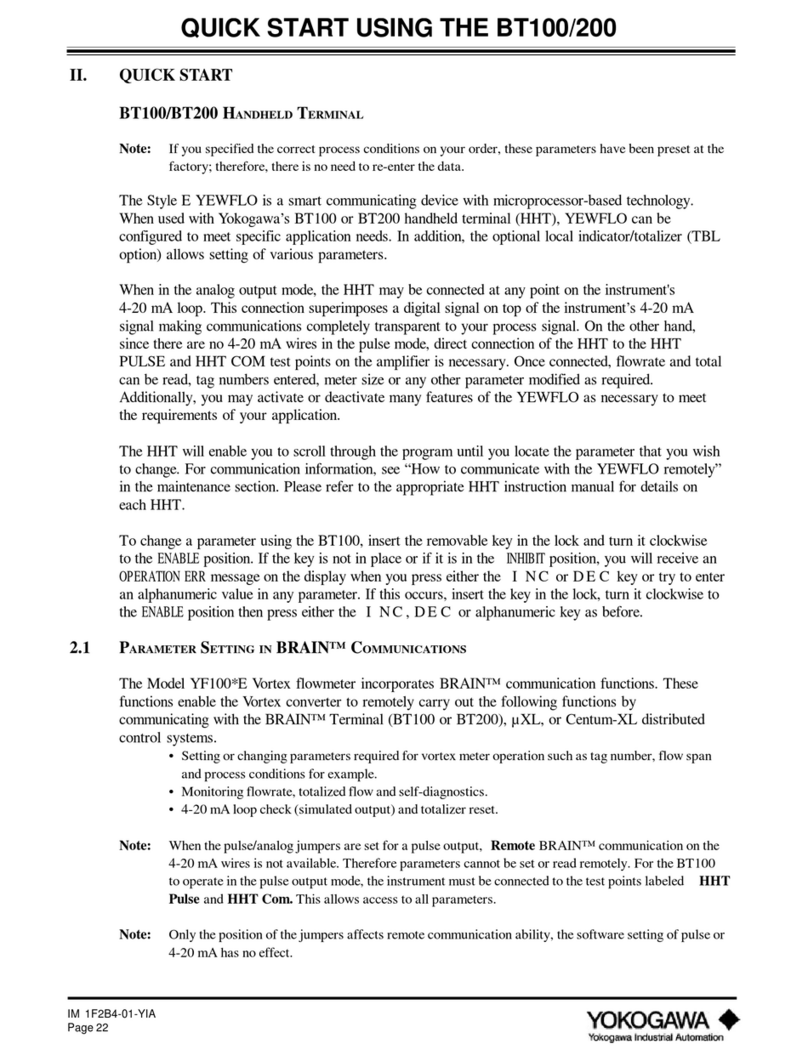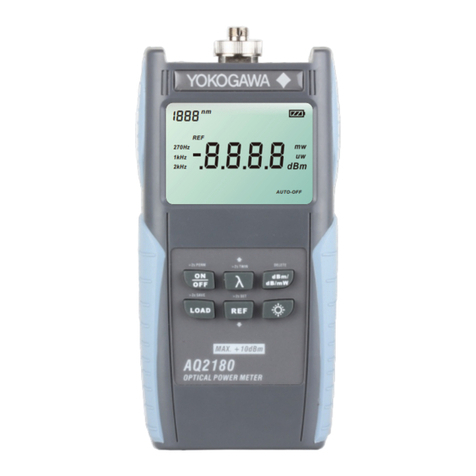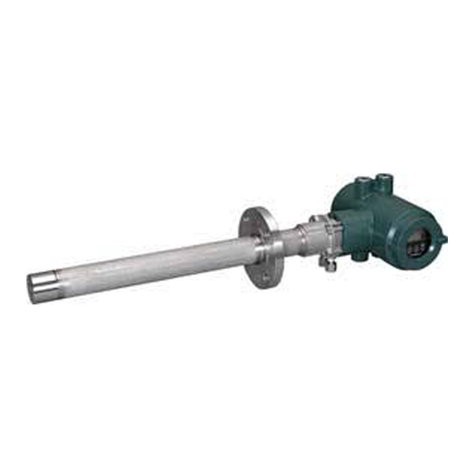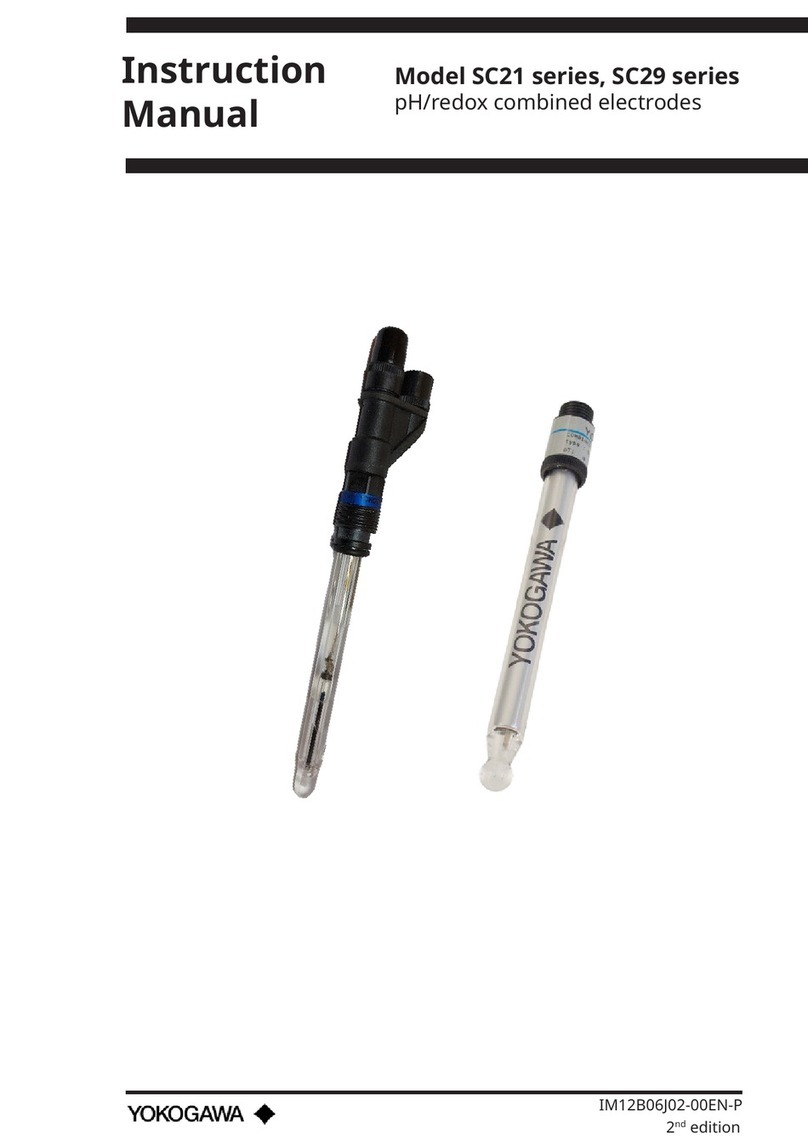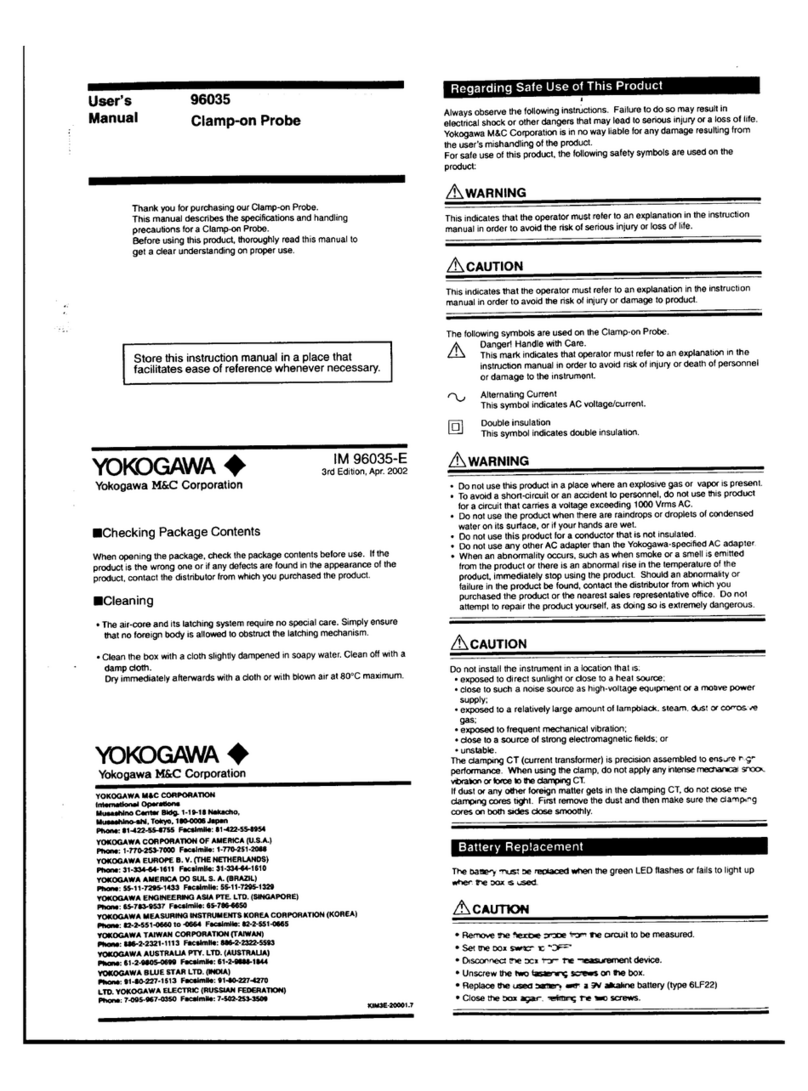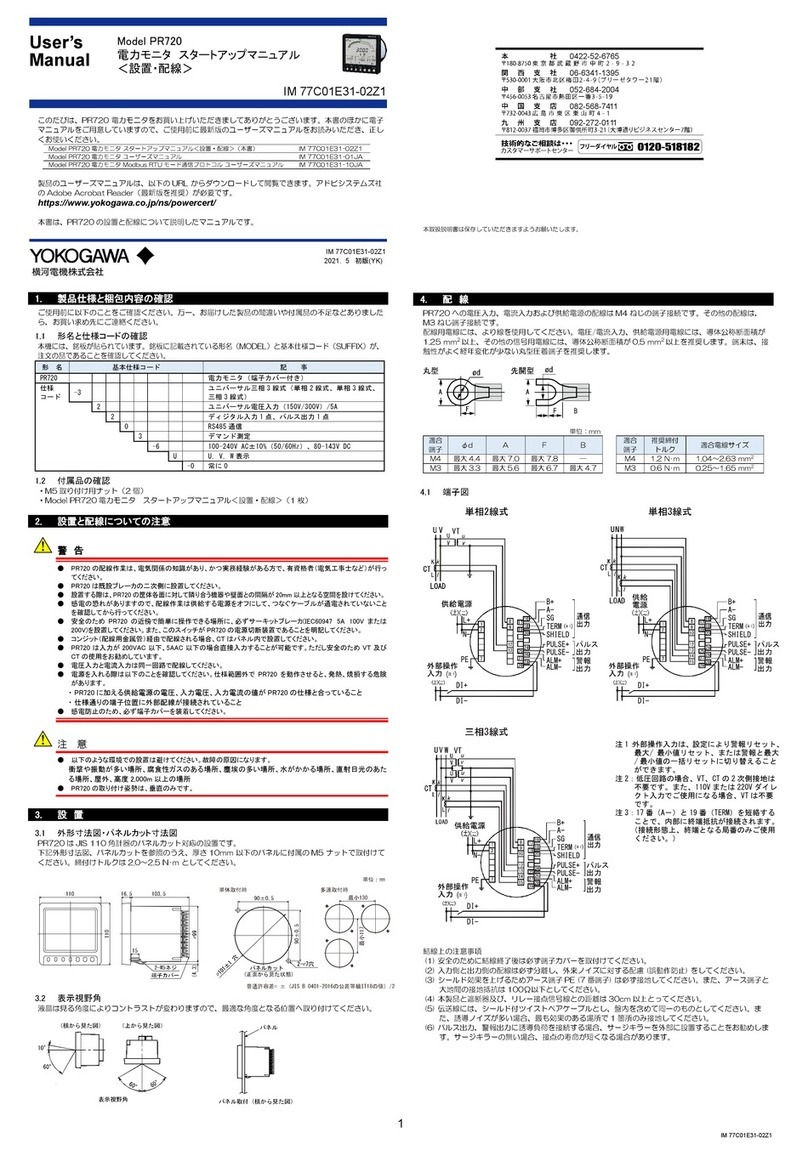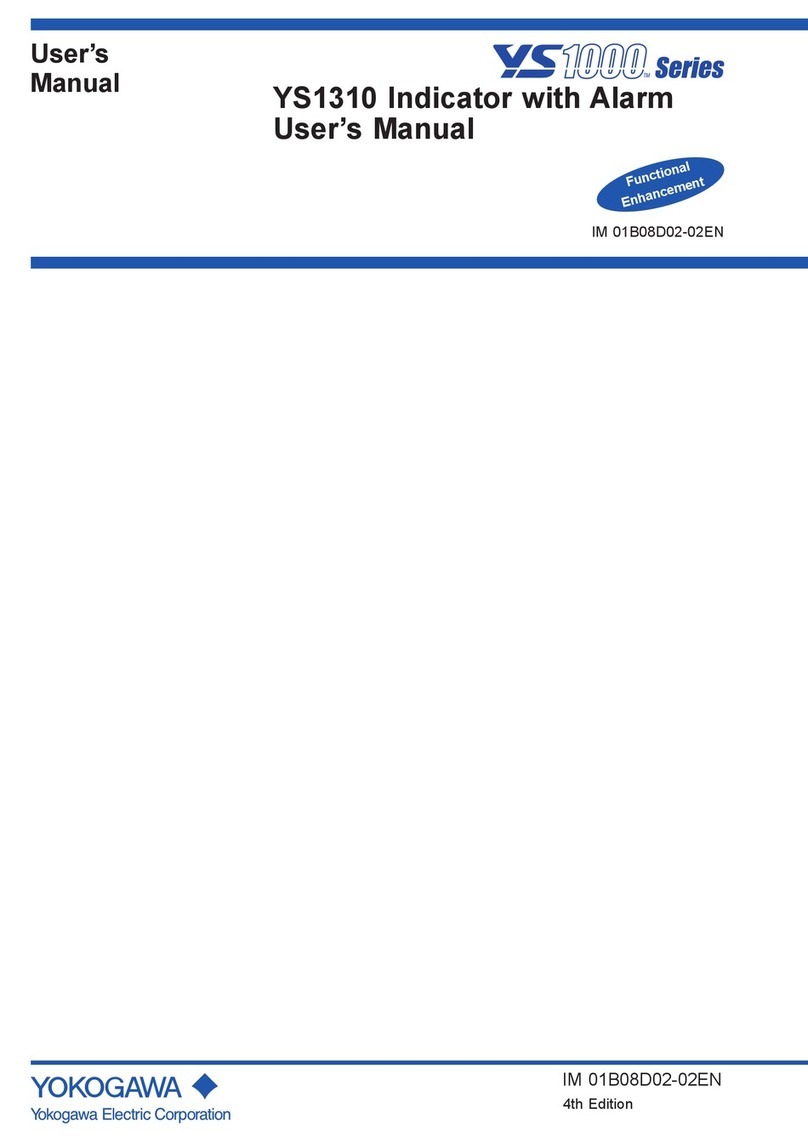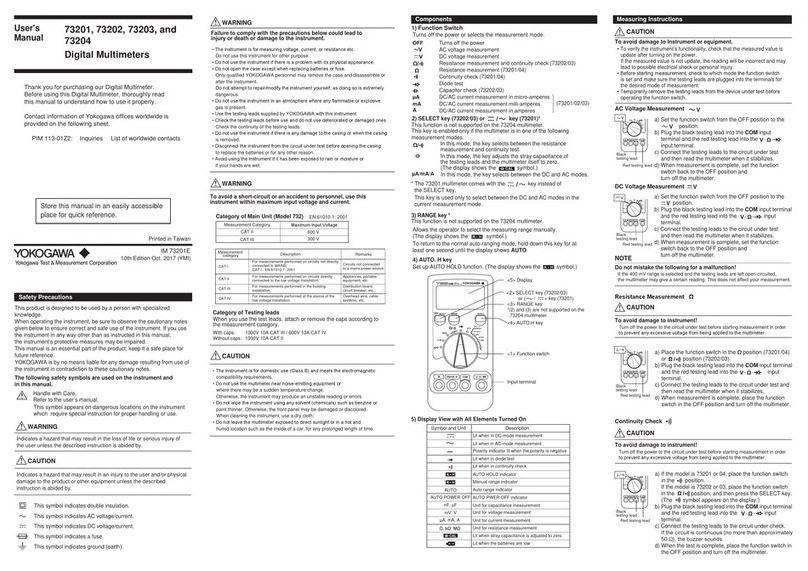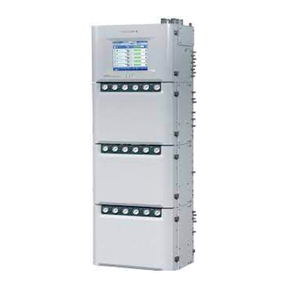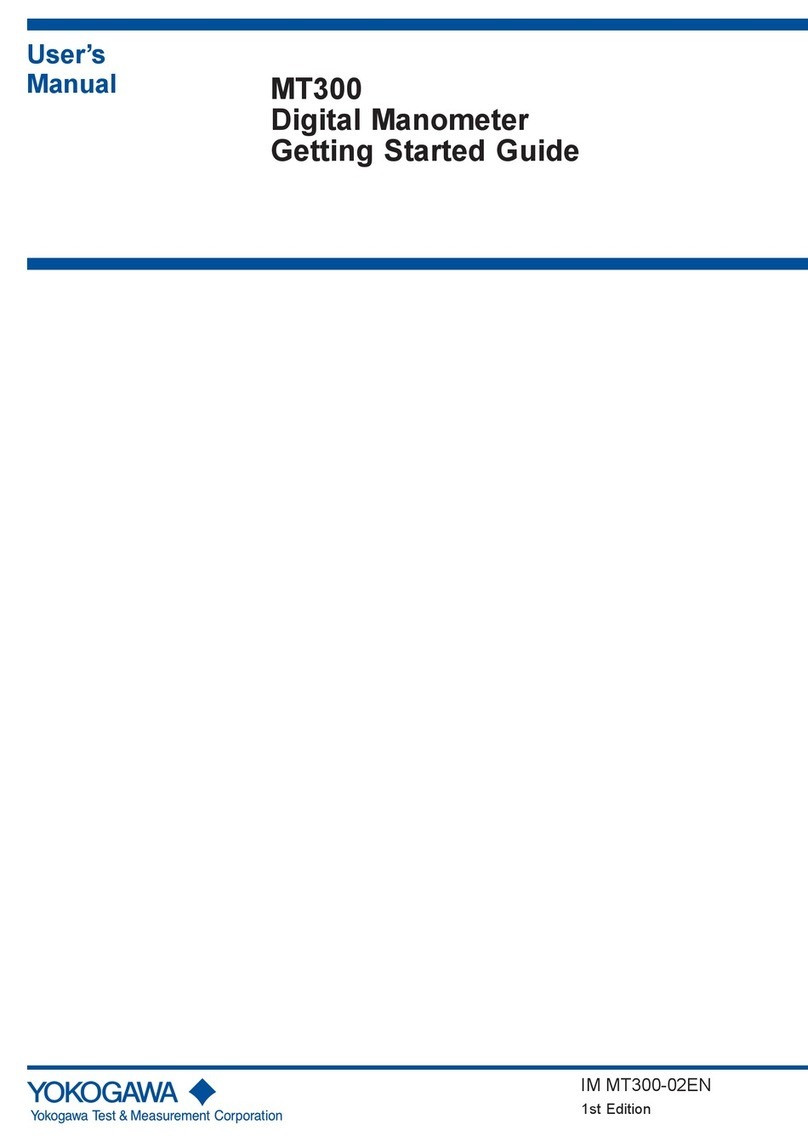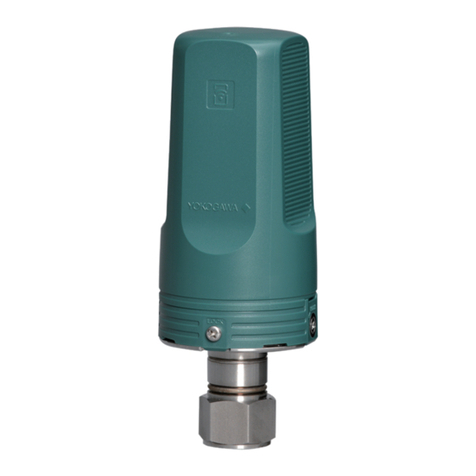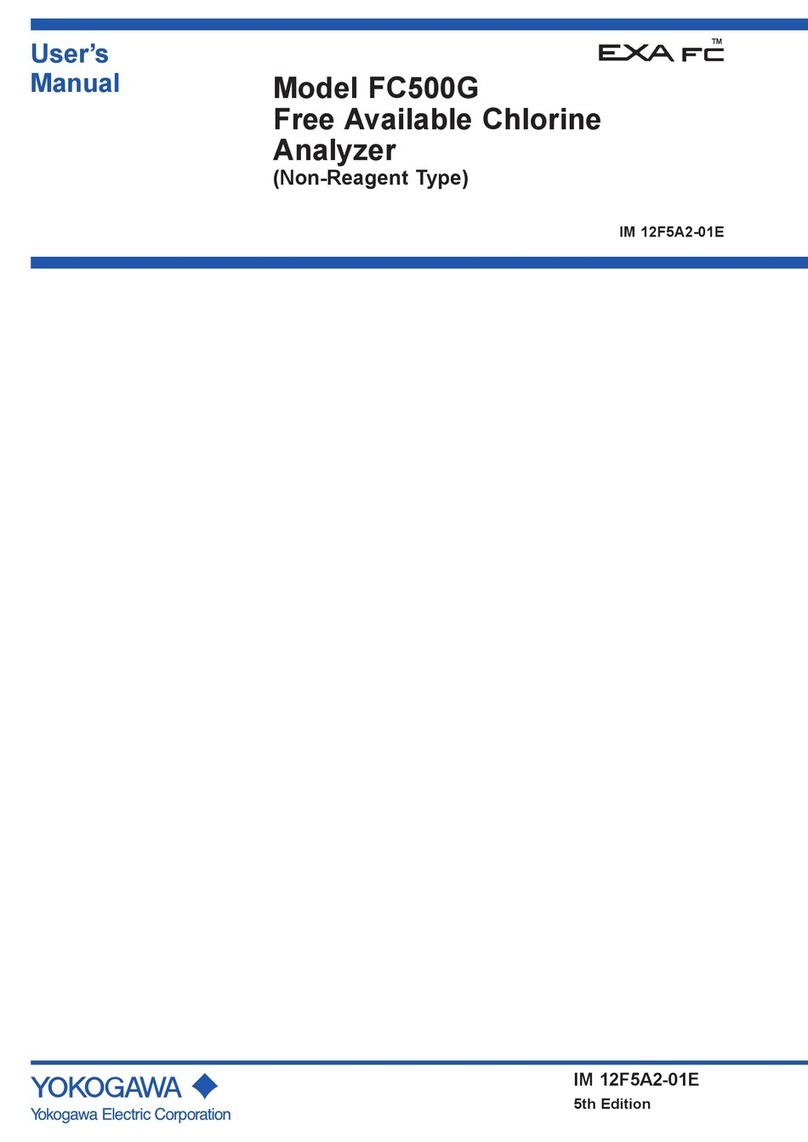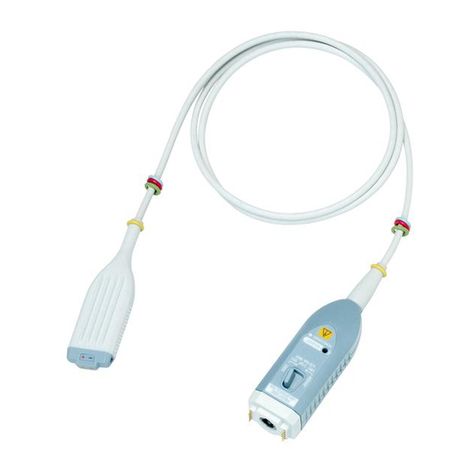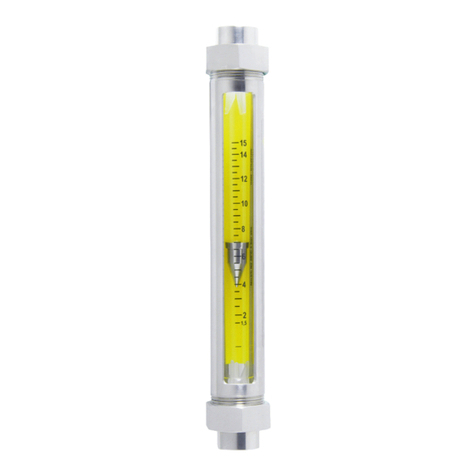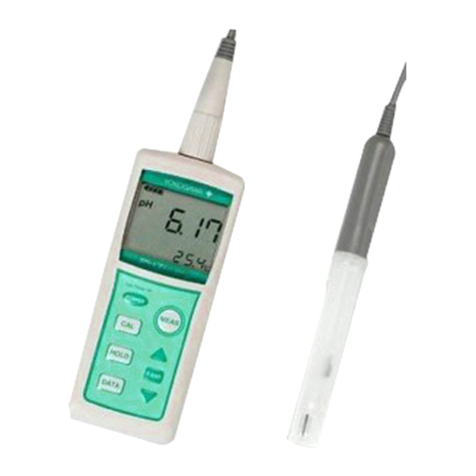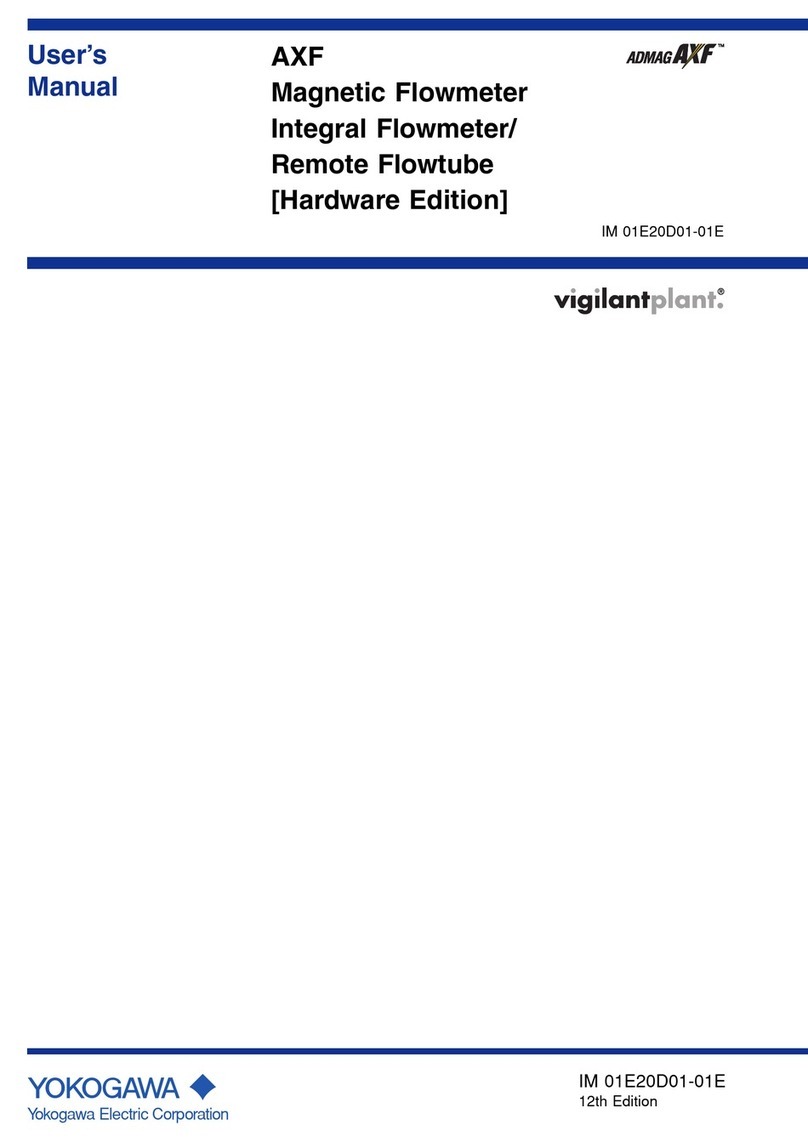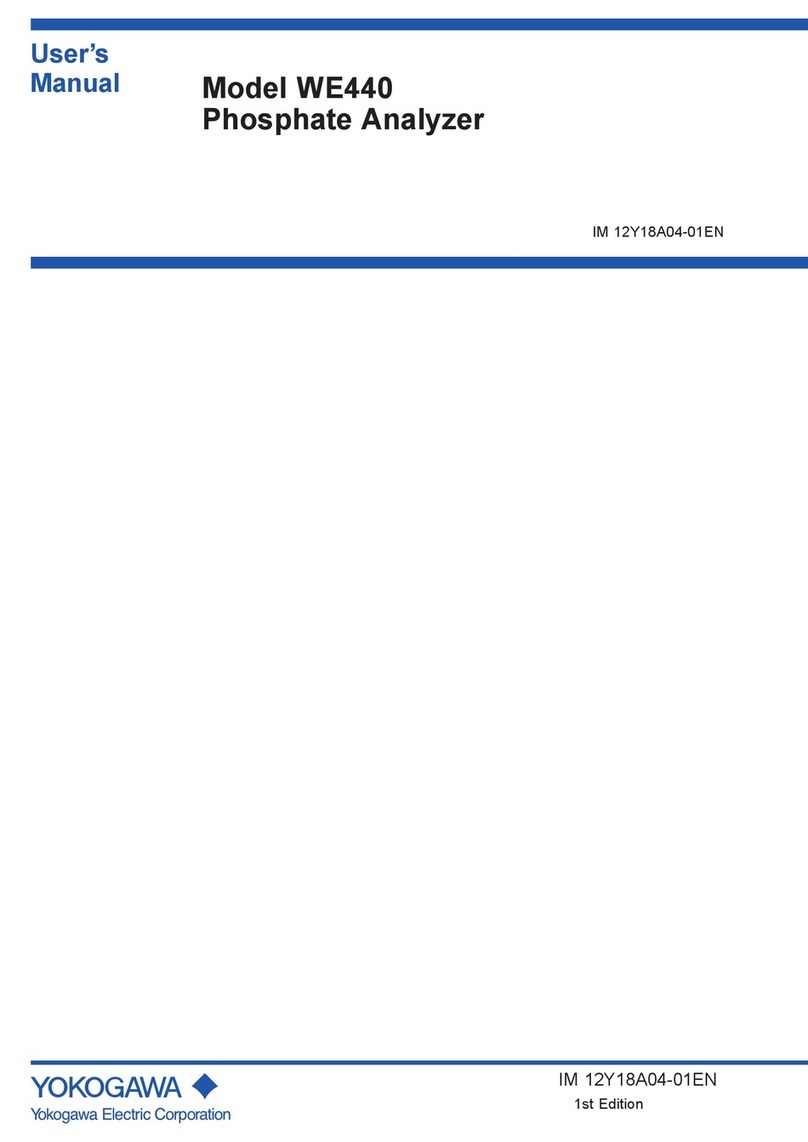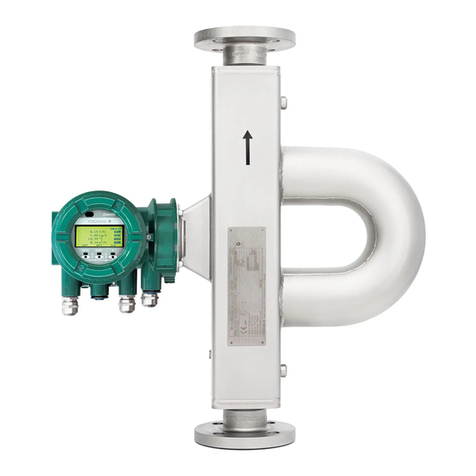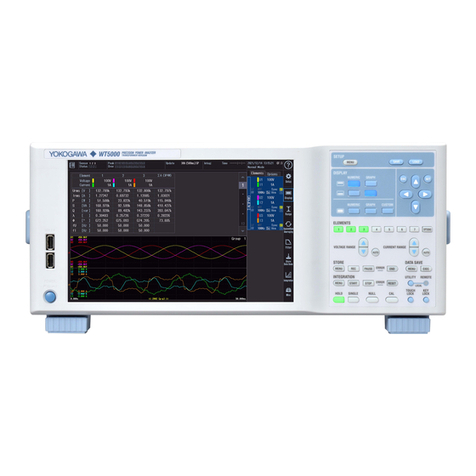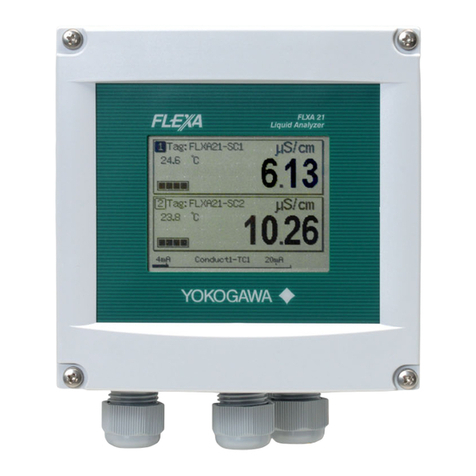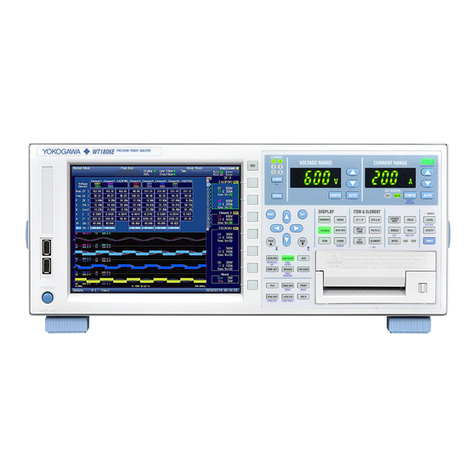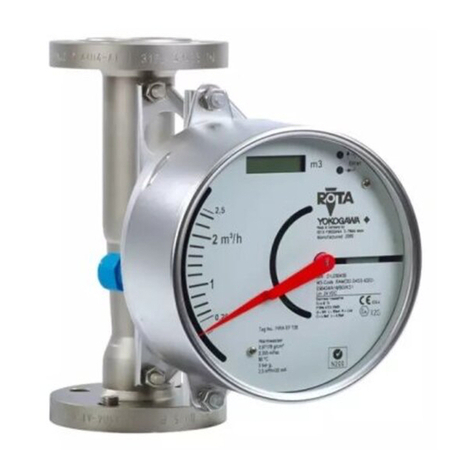
Notes
• The contents of this manual are subject to change without prior notice as a result of continuing
improvements to the product’s performance and functionality. The figures given in this manual may
differ from those that actually appear on your product.
• Every effort has been made in the preparation of this manual to ensure the accuracy of its
contents. However, should you have any questions or find any errors, please contact your nearest
YOKOGAWA dealer.
• Copying or reproducing all or any part of the contents of this manual without the permission of
YOKOGAWA is strictly prohibited.
Conventions Used in This Manual
Improper handling or use can lead to injury to the user or damage to the instrument.
This symbol appears on the instrument to indicate that the user must refer to the
user’s manual for special instructions. The same symbol appears in the corresponding
place in the user’s manual to identify those instructions. In the manual, the symbol is
used in conjunction with the word “WARNING” or “CAUTION.”
WARNING Calls attention to actions or conditions that could cause serious or fatal injury to the
user, and precautions that can be taken to prevent such occurrences.
CAUTION Calls attention to actions or conditions that could cause light injury to the user or
cause damage to the instrument or user’s data, and precautions that can be taken to
prevent such occurrences.
Note
Calls attention to information that is important for the proper operation of the instrument.
French
Une manipulation ou une utilisation incorrectes risquent de blesser l’utilisateur ou
d’endommager l’instrument. Ce symbole apparaît sur l’instrument pour indiquer
à l’utilisateur qu’il doit se reporter au manuel de l’utilisateur afin d’y lire les
instructions spécifiques correspondantes. Ce même symbole apparaît à la section
correspondante du manuel de l’utilisateur pour signaler lesdites instructions. Dans le
manuel de l’utilisateur, ce symbole est accompagné des termes AVERTISSEMENT et
ATTENTION.
AVERTISSEMENT Attire l’attention sur des gestes ou des conditions susceptibles de provoquer
des blessures graves (voire mortelles), et sur les précautions de sécurité
pouvant prévenir de tels accidents.
ATTENTION Attire l’attention sur des gestes ou des conditions susceptibles de provoquer des
blessures légères ou d’endommager l’instrument ou les données de l’utilisateur, et
sur les précautions de sécurité susceptibles de prévenir de tels accidents.
Safety Precautions
This product is designed to be used by a person with specialized knowledge. To use this product
correctly and safely, the general safety precautions described herein must be observed during all
phases of operation. YOKOGAWA assumes no liability for the customer’s failure to comply with these
requirements.
This manual is part of the product and contains important information. Keep this manual in a safe
place so that you can refer to it immediately when using the product until you dispose of the product. In
addition, before using the probe, read the manuals of the oscilloscope to thoroughly familiarize yourself
with its specifications and operations.
The following symbols are used on this instrument.
Handle with care. Refer to the user’s manual or service manual. This symbol appears on
dangerous locations on the instrument which require special instructions for proper handling
or use. The same symbol appears in the corresponding place in the manual to identify those
instructions.
French
À manipuler délicatement. Toujours se reporter aux manuels d’utilisation et d’entretien. Ce
symbole a été apposé aux endroits dangereux de l’instrument pour lesquels des consignes
spéciales d’utilisation ou de manipulation ont été émises. Le même symbole apparaît à l’endroit
correspondant du manuel pour identifier les consignes qui s’y rapportent.
Notes about Usage
WARNING
Purpose of the product
The product is used in combination with a measuring instrument to observe and measure
electrical signals. Do not use for any other purpose.
Observe the maximum input voltage
Do not apply any voltages exceeding the maximum input voltage to the probe.
Be careful of electric shock
Never use the probe with wet hands or when the probe itself is wet. Doing so may cause
electric shock. Be careful of electric shock when you connect the probe to the device under
measurement.
Do not operate in wet or damp conditions
To prevent electric shock, do not operate the probe in wet or damp conditions.
Avoid exposed circuitry
To prevent electric shock, remove watches, rings or other metal jewelry. Do not touch
exposed connections or components when power is present on the device.
Do not operate in explosive atmosphere
To prevent injury or fire hazard, do not operate the probe in an atmosphere of flammable or
explosive gases or vapors.
Be careful of burns and frostbite
When the probe is connected to a device under measurement that is hot or cold, do not
touch the probe directly. In such situations, the probe will also be hot or cold, and touching
it may cause burns or frostbite. Also, be careful of burns and frostbite when you connect the
probe to such device under measurement.
Do not operate with suspected failures
Stop using the probe if you suspect that the probe is damaged. Consult your nearest
YOKOGAWA dealer.
Do not operate with a damaged cable
Stop using the probe if the probe cable is torn and the inner metal is exposed or if a color
different from the outer sheath appears.
Do not disassemble or modify
Do not disassemble or modify the product. YOKOGAWA assumes no liability if you
disassemble or modify the product.
Thank you for purchasing the Model 702902, 10:1 Passive Probe (Wide operating temperature range,
for isolated BNC input). To ensure correct use, please read this manual thoroughly before beginning
operation. After reading this manual, keep it in a safe place.
IM 702902-01EN
7th Edition
French
AVERTISSEMENT
But du produit
Le produit est utilisé en association avec un instrument de mesure pour observer et mesurer
des signaux électriques. Ne l’utilisez pas à d’autres fins.
Respecter la tension d’entrée maximum
Ne pas appliquer à la sonde de tension dépassant la tension d’entrée maximum.
Faites attention au choc électrique
N’utilisez jamais la sonde les mains mouillées ou lorsque la sonde elle-même est mouillée.
Cela pourrait provoquer un choc électrique. Faites attention au choc électrique lorsque vous
connectez la sonde à l’appareil à mesurer.
N’opérez pas dans des conditions mouillées ou humides
Pour éviter un choc électrique, ne faites pas fonctionner la sonde dans des conditions
mouillées ou humides.
Évitez les circuits exposés
Pour éviter les chocs électriques, retirez les montres, bagues ou autres bijoux en métal. Ne
touchez pas les connexions ou composants exposés en présence de courant sur l’appareil.
N’opérez pas dans une atmosphère explosive
Pour éviter les blessures et les risques d’incendie, n’utilisez pas la sonde dans une
atmosphère de gaz ou des vapeurs inflammables ou explosifs.
Attention aux brûlures et aux engelures
Lorsque la sonde est connectée à un appareil en cours de mesure qui est chaud ou froid,
ne touchez pas directement la sonde. Dans de telles situations, la sonde sera également
chaude ou froide et son contact peut provoquer des brûlures ou engelures. Faites également
attention aux brûlures et aux engelures lorsque vous connectez la sonde à un tel appareil en
cours de mesure.
N’opérez pas en cas de défaillances suspectées
Arrêtez d’utiliser la sonde si vous pensez qu’elle est endommagée. Consultez votre
revendeur YOKOGAWA le plus proche.
N’opérez pas avec le câble de signal endommagé
Si le câble de signal est coupé et que le métal interne est exposé ou si une couleur différente
de la gaine extérieure apparaît, arrêtez d’utiliser le câble.
Ne démontez ou modifiez pas
Ne démontez ou modifiez pas le produit. YOKOGAWA n’assume aucune responsabilité si
vous démontez ou modifiez le produit.
Regulations and Sales in Various Countries and Regions
Waste Electrical and Electronic Equipment (WEEE)
(EU WEEE Directive valid only in the EEA* and UK WEEE Regulation in the UK)
This product complies with the WEEE marking requirement. This marking indicates
that you must not discard this electrical/electronic product in domestic household
waste. When disposing of products in the EEA or UK, contact your local Yokogawa
office in the EEA or UK respectively.
* EEA: European Economic Area
UKCA Marking
This product complies with the UKCA (UK Conformity Assessed) marking.
Authorized Representative in the EEA (AR)
Yokogawa Europe B. V. is the authorized representative of Yokogawa Test & Measurement
Corporation for this product in the EEA. To contact Yokogawa Europe B. V., see the separate list of
worldwide contacts, PIM 113-01Z2.
Disposal
When disposing of YOKOGAWA products, follow the laws and ordinances of the country or region
where the product will be disposed of.
1. Overview
The 702902 is a 10:1 passive probe that provides high-voltage measurement when used together
with an isolated input measuring instrument. It can be used over a wide temperature range (–40°C
to +85°C). Except for the tip of the probe, the probe and BNC connector are isolated so that
dangerous voltages are not accidentally exposed. Make sure you also fully understand the correct
use of the measuring instrument when using the probe.
2. Configuration and Part Names
yellow
green
magenta
cyan
red
orange
light blue
purple
4
3
2Phase adjustment knob
1
6
7
5
BNC connetor
Probe cable
8910
Signal end
Ground
Phase adjustment part
No. Standard Parts Part No. No. Optional Accessories
(Sold separately)
Part No.
1. Probe – 6. 4Φ conversion adapter (signal end) B8099NL
2. Pincher tip B8099NJ 7. 4Φ conversion adapter (ground) B8099NM
3. Safety ground lead B8099NK 8. Pincher tip B9852MN (red)
B9852MM (black)
4. Marker tip (8 colors x 2) –
5. Manuals
(see the table below)
– 9. Alligator clip adapter (red/black) 758929
10. Fork terminal adapter (red/black) 758921
Manual Title Manual No. Description
Model 702902 10:1 Passive Probe
(Wide operating temperature range,
for isolated BNC input) User’s Manual
IM 702902-01EN
This manual. It explains the handling
precautions, basic usage, and
specifications of the instrument.
Model 702902 10:1 Passive Probe
(Wide operating temperature range,
for isolated BNC input)
IM 702902-92Z1 Document for China
Safety Instruction Manual IM 00C01C01-01Z1 Safety manual
(European languages)
Inquiries PIM 113-01Z2 List of worldwide contacts
The “EN”, “Z1”, and “Z2” in the manual numbers are the language codes.
3. How to Use
WARNING
• Use the probe only with the YOKOGAWA’s isolated-input measuring instrument. And the
probe can be used only when specified as an accessory for the measuring instrument to
be used.
• When connecting the probe to the object under measurement, be careful of electric
shock, burns, and frostbite.
• Do not apply voltage exceeding 1000 V between a pincher tip and safety ground lead or
between a safety ground lead and ground.
Model 702902
10:1 Passive Probe
(Wide operating temperature range,
for isolated BNC input)
7th Edition : May 2022 (YMI)
All Rights Reserved, Copyright © 2014, Yokogawa Test & Measurement Corporation
Printed in Japan
IM 702902-01EN 1/2
